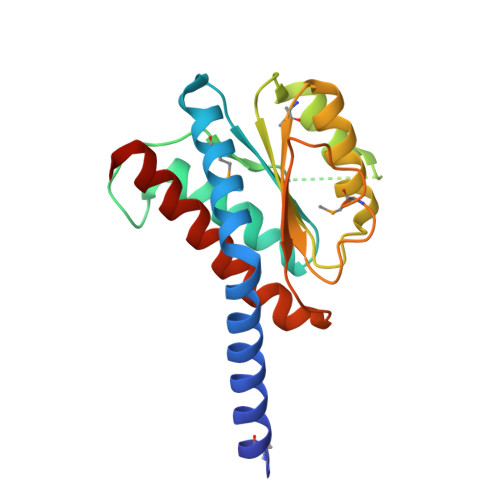Structure and Function of Sedoheptulose-7-phosphate Isomerase, a Critical Enzyme for Lipopolysaccharide Biosynthesis and a Target for Antibiotic Adjuvants.
Taylor, P.L., Blakely, K.M., de Leon, G.P., Walker, J.R., McArthur, F., Evdokimova, E., Zhang, K., Valvano, M.A., Wright, G.D., Junop, M.S.(2008) J Biol Chem 283: 2835-2845
- PubMed: 18056714
- DOI: https://doi.org/10.1074/jbc.M706163200
- Primary Citation of Related Structures:
1X92, 2I22, 2I2W, 3BJZ - PubMed Abstract:
The barrier imposed by lipopolysaccharide (LPS) in the outer membrane of Gram-negative bacteria presents a significant challenge in treatment of these organisms with otherwise effective hydrophobic antibiotics. The absence of L-glycero-D-manno-heptose in the LPS molecule is associated with a dramatically increased bacterial susceptibility to hydrophobic antibiotics and thus enzymes in the ADP-heptose biosynthesis pathway are of significant interest. GmhA catalyzes the isomerization of D-sedoheptulose 7-phosphate into D-glycero-D-manno-heptose 7-phosphate, the first committed step in the formation of ADP-heptose. Here we report structures of GmhA from Escherichia coli and Pseudomonas aeruginosa in apo, substrate, and product-bound forms, which together suggest that GmhA adopts two distinct conformations during isomerization through reorganization of quaternary structure. Biochemical characterization of GmhA mutants, combined with in vivo analysis of LPS biosynthesis and novobiocin susceptibility, identifies key catalytic residues. We postulate GmhA acts through an enediol-intermediate isomerase mechanism.
Organizational Affiliation:
Department of Biochemistry and Biomedical Sciences, DeGroote School of Medicine, McMaster University, 1200 Main Street West, Hamilton, Ontario, Canada.

















